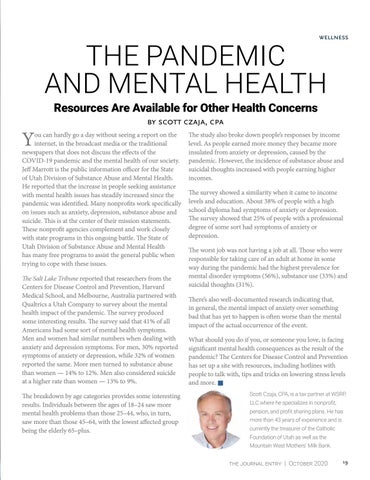wellness
THE PANDEMIC AND MENTAL HEALTH Resources Are Available for Other Health Concerns
Y
By Scott Czaja, CPA
ou can hardly go a day without seeing a report on the internet, in the broadcast media or the traditional newspapers that does not discuss the effects of the COVID-19 pandemic and the mental health of our society. Jeff Marrott is the public information officer for the State of Utah Division of Substance Abuse and Mental Health. He reported that the increase in people seeking assistance with mental health issues has steadily increased since the pandemic was identified. Many nonprofits work specifically on issues such as anxiety, depression, substance abuse and suicide. This is at the center of their mission statements. These nonprofit agencies complement and work closely with state programs in this ongoing battle. The State of Utah Division of Substance Abuse and Mental Health has many free programs to assist the general public when trying to cope with these issues. The Salt Lake Tribune reported that researchers from the Centers for Disease Control and Prevention, Harvard Medical School, and Melbourne, Australia partnered with Qualtrics a Utah Company to survey about the mental health impact of the pandemic. The survey produced some interesting results. The survey said that 41% of all Americans had some sort of mental health symptoms. Men and women had similar numbers when dealing with anxiety and depression symptoms. For men, 30% reported symptoms of anxiety or depression, while 32% of women reported the same. More men turned to substance abuse than women — 14% to 12%. Men also considered suicide at a higher rate than women — 13% to 9%. The breakdown by age categories provides some interesting results. Individuals between the ages of 18–24 saw more mental health problems than those 25–44, who, in turn, saw more than those 45–64, with the lowest affected group being the elderly 65–plus.
The study also broke down people’s responses by income level. As people earned more money they became more insulated from anxiety or depression, caused by the pandemic. However, the incidence of substance abuse and suicidal thoughts increased with people earning higher incomes. The survey showed a similarity when it came to income levels and education. About 38% of people with a high school diploma had symptoms of anxiety or depression. The survey showed that 25% of people with a professional degree of some sort had symptoms of anxiety or depression. The worst job was not having a job at all. Those who were responsible for taking care of an adult at home in some way during the pandemic had the highest prevalence for mental disorder symptoms (56%), substance use (33%) and suicidal thoughts (31%). There’s also well-documented research indicating that, in general, the mental impact of anxiety over something bad that has yet to happen is often worse than the mental impact of the actual occurrence of the event. What should you do if you, or someone you love, is facing significant mental health consequences as the result of the pandemic? The Centers for Disease Control and Prevention has set up a site with resources, including hotlines with people to talk with, tips and tricks on lowering stress levels and more. n Scott Czaja, CPA, is a tax partner at WSRP, LLC where he specializes in nonprofit, pension, and profit sharing plans. He has more than 43 years of experience and is currently the treasurer of the Catholic Foundation of Utah as well as the Mountain West Mothers’ Milk Bank.
the journal entry | October 2020
19
